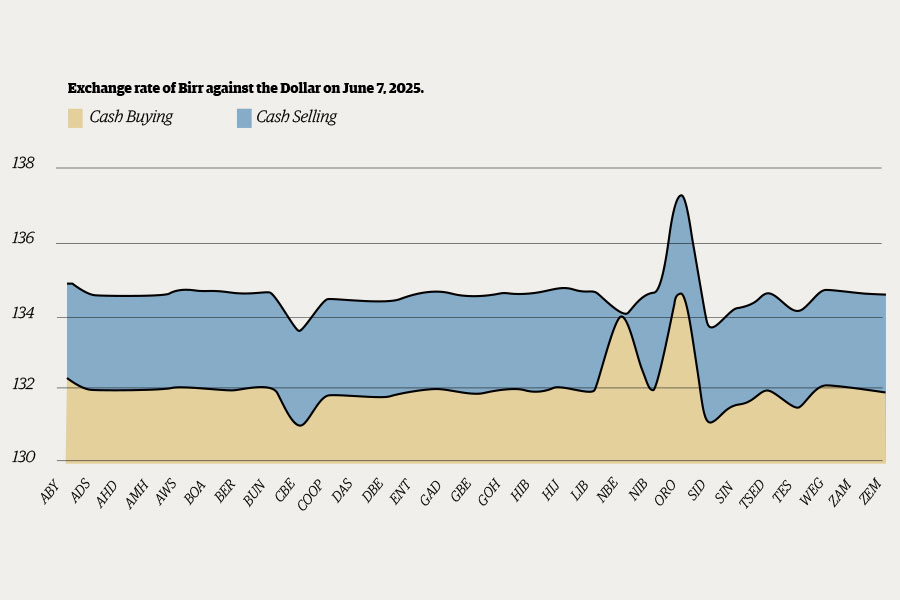
Fortune News | Oct 23,2021
Jul 30 , 2022.
Ethiopia’s banking industry is not merely underdeveloped. It has historically regressed. Calls for the financial sector to open for international capital, technology, network and skill remain dwarfed in the face of nationalistic disguise to shelter it from foreign competition. Perhaps the die-hard protectionists who have taken economic policy discourse hostage would be surprised to find out that the first bank established was a concession deal given to non-nationals.
The Bank of Abyssinia, as it was called, was established in 1906 with half a million pounds of authorised capital. Formed to process transactions and mint coins, it was managed by the National Bank of Egypt (owned by the British). Part of the equity financing for the bank was to be raised in stock exchanges in London and Paris. The Bank hung around until 1931. The first bank to be majority owned by nationals, the Bank of Ethiopia, was set up afterwards, following the Imperial government payout of 40,000 pounds as a breakup fee to the Egyptian bank.
Those remain the most revolutionary times for banking in Ethiopia. At its peak, the financial sector may have been highly underdeveloped, but it was open and thriving. A significant milestone was in 1963 when central banking was separated from commercial functions. Even then, as long as locals owned most of the shares, joint ventures with foreign banks were permitted. The first domestically owned private bank that came afterwards, Addis Ababa Bank, was 40pc owned by foreign institutions.
The nearly six decades that followed were unfortunate. There was a 17-year of nationalisation and expropriation of private wealth. Post-1991 has brought the resurrection of domestic private capital in the financial sector. But protectionism continued. And the debate rages.
Banking and insurance are saddled with one of the most underdeveloped financial sectors in the world. Ethiopia’s is a society largely unbanked. Credit is an undistributed risk, and access to it is limited to a fraction of its population. There remains strong resistance to shielding the industry from foreign capital.
What is the alternative to opening up?
There could be more of what came before - a wave of private banks mirroring those who had entered the market. Innovation in products or services is rare. Competition is good but does not always mean growth. Offering not much different from one another, it is a pitched battle for several banks over deposits, forex and labour. The banking industry is currently the poster child for this: deprived of innovation and bogged down in repetition.
The new ones are doing more of the same, bar their logos and corporate colours.
Several banks have commenced operations over the past few months, the latest being Tsehay, Ahadu and Amhara banks. The industry is seeing a wave of entrants beginning last year, when ZamZam and Hijira banks, which exclusively offer interest-free services, and Goh Betotch, a mortgage banker, began operations. A few more are expected to inaugurate their services, including microfinance institutions edging to graduate into retail banking. There would have been more had the central bank not increased the minimum required paid-up capital 10-fold to five billion Birr.
The latest entrants are the fourth generation to join the industry since the banking industry was opened to private capital in 1995. The first generation, with the likes of Awash, Abyssinia, Dashen, Hibret and Wegagen banks, waved into the industry only to bring little innovation and energy. The fourth generation of banks will likely not change this state of affairs.
The youngest banks will give the established ones a run for their money. The well-capitalised ones, Amhara Bank and former microfinance institutions, could be formidable. They will mobilise deposits aggressively and compete for clients that buy products. Smaller and weaker banks will eventually be challenged, making the industry leaner and more robust.
But will they go far enough?
Profit losses are rare in the industry, and no private bank has ever been bought out or merged. However, tough times are ahead if the declining return on share is any indication.
The financial sector cannot do much for the main economy that it did do two decades ago. While more people have bank accounts, the other frontiers such as digital banking, access to credit and product innovation remain weak. The banks are unspecialised (concentrated in retail banking) and face a significant skills gap. There is generally low awareness and investment in the financial sector (in the form of financial assets) by the public.
What will Tsehay, Ahadu or Amhara banks offer in products and services that Awash, Abyssinia, or Wegagen banks are not? What is their differentiation in value proposition?
They have yet to say much.
It would be unfair to hold the private banks responsible for all the inadequacies in the financial sector. They operate under the gaze of a constraining regulatory environment and difficult economic realities. They are merely responding to incentives. It could be unfair to hold private commercial banks and insurance firms responsible for the state of the sector. The role lies with central bankers and policymakers steering economic planning.
The whole ecosystem needs to change for the financial sector to grow and the economy to be financialised. What has elevated the banking sector in the world’s financial centres is reduced regulation, robust infrastructure, strong contract enforcement laws and ease of capital movement. A lesson can be taken and replicated in Ethiopia if there is a willingness to accept that meaningful competition may not be good for a few inefficient firms but creates a competitive economy as a whole.
It can start with a bit of house cleaning. It will go a long way if the central bank regulates consistently, formally and in predictable ways. This means not communicating important policy changes informally through text messages to bank presidents. The institution can also lead by example. It wants commercial banks to be transparent while it remains highly secretive and tight-lipped about macroeconomic policy directions, if its governors have one.
The central bank cannot bring the change needed in the finance sector by itself, nonetheless. The industry’s laws must be amended to open the sector to foreign capital, bringing meaningful competition. It will not otherwise be possible to leapfrog from a traditional banking system to the modern financial advances and innovations of the day.
Opening the banking sector for foreign capital does not in and of itself guarantee that incomers will gladly waltz into Ethiopia, knowing that profit repatriation is not allowed. Opening the banking industry thus needs to be followed with capital account liberalisation. It is give-and-take, and the government has to give in.
It is encouraging to see Ethiopia’s authorities preparing the roadway to establish capital markets. This will be essential for the financial sector to grow, widening the space for domestic and foreign newcomers to thrive. Managed well, it can open avenues for raising equity (both government and private sector), diversifying and distributing risks and opening alternative sources of investments for the general public.
This is a credit to the current policymakers. They should take the energy and apply it to opening up to global capital.
PUBLISHED ON
Jul 30,2022 [ VOL
23 , NO
1161]

Fortune News | Oct 23,2021

Fortune News | Feb 26,2022

Commentaries | Feb 12,2022

Fortune News | Apr 06,2019

My Opinion | Jul 22,2023

Fortune News | Dec 04,2022

Fortune News | Sep 09,2023

Radar | Apr 06,2019

Radar | Dec 29,2018

Money Market Watch | Jun 08,2025

My Opinion | 131548 Views | Aug 14,2021

My Opinion | 127903 Views | Aug 21,2021

My Opinion | 125879 Views | Sep 10,2021

My Opinion | 123510 Views | Aug 07,2021

Dec 22 , 2024 . By TIZITA SHEWAFERAW
Charged with transforming colossal state-owned enterprises into modern and competitiv...

Aug 18 , 2024 . By AKSAH ITALO
Although predictable Yonas Zerihun's job in the ride-hailing service is not immune to...

Jul 28 , 2024 . By TIZITA SHEWAFERAW
Unhabitual, perhaps too many, Samuel Gebreyohannes, 38, used to occasionally enjoy a couple of beers at breakfast. However, he recently swit...

Jul 13 , 2024 . By AKSAH ITALO
Investors who rely on tractors, trucks, and field vehicles for commuting, transporting commodities, and f...

Jun 29 , 2025
Addis Abeba's first rains have coincided with a sweeping rise in private school tuition, prompting the city's education...

Jun 29 , 2025 . By BEZAWIT HULUAGER
Central Bank Governor Mamo Mihretu claimed a bold reconfiguration of monetary policy...

Jun 29 , 2025 . By BEZAWIT HULUAGER
The federal government is betting on a sweeping overhaul of the driver licensing regi...

Jun 29 , 2025 . By NAHOM AYELE
Gadaa Bank has listed 1.2 million shares on the Ethiopian Securities Exchange (ESX),...